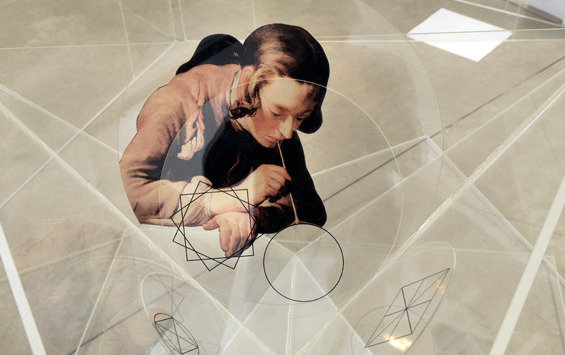Giulio Paolini
dal 7/7/2014 al 13/9/2014
Segnalato da
7/7/2014
Giulio Paolini
Whitechapel, London
To Be or Not to Be. Installations of canvases, windows, fragments of statuary and checkerboards - sometimes presented by 18th century footmen. The exhibition presents his work since 1980, including key works from the 1960s to the present day and a new installation created specially for the show.

Giulio Paolini: To Be or Not to Be is co-curated by guest curator Bartolomeo Pietromarchi and Daniel F. Herrmann, Eisler Curator and Head of Curatorial
Studies, Whitechapel Gallery, with Emily Butler, Assistant Curator, Whitechapel Gallery.
Italian artist Giulio Paolini’s
(b.1940)
installations are deeply rooted in art history
from the Renaissance to today
-
with
plaster casts of classical sculptures to
reproductions of
iconic paintings by
Chardin,
Lotto
and
Velázquez.
The
Whitechapel Gallery presents
the first major
UK
exhibition
of his work since 1980,
including
key works from the 1960s to the present day
and
a new installation
created
specially
for the show.
Giulio Paolini
is a leading figure in Conceptual Art and
came to prominence as part
of a generation of
Italian artists
including
Michelangelo Pistoletto and Mario Merz.
His
belief that a work of art is not just itself in the ‘here and now’ but also the
record of earlier traditions, has led him to investigate art's relation to the past.
Driven by an exploration into the nat
ure of images, the making of art and the role
of the artist,
Paolini
asserts that ‘
to be
authentic, a work of art
must forget about
its author.’
Giulio Paolini:
To Be
or Not t
o Be
,
referencing
William Shakespeare’s
Hamlet,
features
Paolini’s
sculptures, installations and photographs which explore the
relationship between the artist and the artwork.
Visual clues about the presence
and role of the artist are scattered throughout the
works
,
from self
-
portraits to
recurring motifs of the arti
st’
s hands
and
eyes.
Gallery 1 includes a comprehensive array of
pivotal
historic works.
In the centre of
the gallery, the large
-
scale floor piece
Essere o non essere
(
To B
e
or Not
t
o B
e)
(1994
-
95)
is laid out like a checkerboard strewn with canvases, pencils and
drawings, pointing to
a
continual process of construction and deconstruction.
Other highlights
include
Delfo
(Delphi)
(1965), a
photographic self
-
portrait of the
artist
wearing dark glasses,
confronting the viewer from behind
the wooden
supports of
an unstretched painting and
Acadé
mie 3
(1965), feat
uring vibrant blue
brushstrokes
superimposed
onto
a
photograph of Paolini
himself.
Gallery 1
continues with one of Paolini’s most iconic works,
In Giovane che guarda Lorenzo
Lotto
(Young Man Looking at Lorenzo Lotto) (1967),
an actual
-
size reproduction of
a
1505
portrait by
Italian Renaissance painter
Lotto, reversing the roles of the
artist and the viewer.
In Galleries 8 and 9
a sequence of inst
allations are theatrically staged, playing on
shadows and
light
. Often appearing as if the artist has just left, the works focus on
the artist’s studio and working processes.
In
Big Bang
(1997
-
8) a
miniature
artist’s
studio
is surrounded by works in progress with canvases and scrunched up papers
seemingly thrown
across the floor
.
Throughout the space,
Contemplator enim
(1992), a complex plexiglas structure, features images of two valets taken from
eighteenth century theatre,
each presenting placeholders for images to the visitor.
The exhibition
closes
with
a new installation
,
L’autore che credeva di esistere
(sipario: buio in sala)
(The Author Who Thought He Existed (Curtain: Darkness
Falls Over the Auditorium))
(2013)
,
whic
h evokes an abandoned artist’s studio with
an upturned chair
and
a workspace covered in
layers
of
drawings and papers.
Giulio Paolini was born in Genoa, Italy, in 1940.
In
1959
he
graduated from
the
Giambattista
Bodoni State Industrial Technical Institute for
Graphic and
Photographic Arts.
He began his artistic research in 1960 and created the
key work
Disegno geometrico
.
In 1964, Paolini had his first solo exhibition at
La Salita in Rome. He was invited by
Germa
no Celant to take part in
a series
of Arte Pover
a exhibitions from 1967 to 1971
. Paolini was nominated as
Chevalier des Arts et des lettres
in 1995
and then Officer in 2002.
Paolini’s
work was included in
past editions of dOCUMENTA,
Kassel, in 1972, 1977,
1982 and 1992.
In 2004 Paolini together with his wife, An
n
a, and his closest
collaborators, founded the Giulio and An
n
a Foundation. He currently lives
and
works in Turin, Italy.
Giulio Paolini:
To Be
or Not
t
o Be
is organised in c
ollaboration with MACRO,
Rome and is an expanded version of the exhibition which was on display
there
from 29 November 2013
–9 March 2014
The exhibition
is
accompanied by
a fully illustrated catalogue published by
MACRO which features essays by leading i
nternational scholars including
Gabriele Guercio, Barry Schwabsky, Bartolomeo Pietromarchi
and Daniel F.
Herrmann.
Giulio Paolini
is
creating a new
limited
edition,
Dopo tutto
(After All) (2014)
for the exhibition.
Image: Alfa (Un autore senza nome) [Alpha (An Author without Name)] (detail) 2004, Mixed media, Collection of the artist / Courtesy Marian Goodman Gallery, New York © Giulio Paolini
Press Information
For further press information and images please contact:
Rachel Mapplebeck, Head of Communications, on 0207 522 7880 or email RachelMapplebeck@whitechapelgallery.org
Anna Jones on 020 7522 7871 or email AnnaJones@whitechapelgallery.org
Media View: 8 July 2014
Whitechapel Gallery
77 – 82 Whitechapel High Street, London E1 7QX
Opening times: Tuesday – Sunday, 11am – 6pm, Thursdays, 11am – 9pm
Admission free



